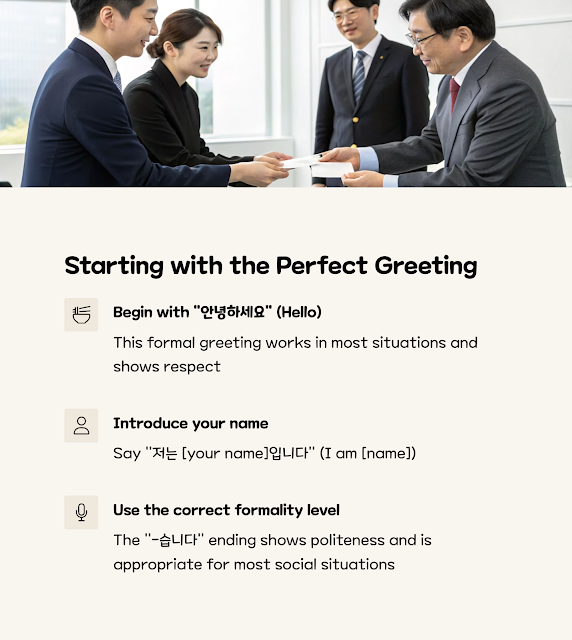Learn how to introduce yourself in Korean with polite phrases, grammar tips, and real examples. Perfect for beginners making a strong first impression!

Mastering Korean Self-Introductions: A Step-by-Step Guide for English Speakers
Learn how to introduce yourself in Korean like a native!
Introducing yourself properly is a fundamental skill in any language, and in Korean, this becomes even more important due to its cultural emphasis on respect and structure. In this blog, we will explore how to master Korean self-introductions step by step, using the most authentic phrases, formal structures, and cultural insights that will help you sound natural and confident. Whether you are a student starting Korean, someone preparing for a trip to Korea, or a professional aiming to connect with Korean clients, this guide will provide a clear, data-backed path to success. We will break down the key phrases, provide example sentences, and share tips that reflect real-life usage. By the end of this guide, you will not only know how to say "Hello" and "My name is..." in Korean, but you will also understand how to convey respect, friendliness, and clarity all in one short speech. Let’s begin your Korean language journey the right way—with confidence, culture, and clarity.
| Korean Greetings | Use "안녕하세요?" for polite, friendly first impressions. |
| Name Structure | Say "저는 [name]입니다" to state your name formally. |
Greeting someone in Korean is the foundation of making a strong first impression. While the phrase "안녕하세요?" is widely recognized and used in most formal and semi-formal settings, many learners overlook the subtle cultural depth embedded in that simple greeting. In Korea, how you greet someone depends greatly on their age, your relationship to them, and the setting of your interaction. A simple "안녕!" may be suitable among friends, but in business or educational environments, it can come off as immature or disrespectful. Understanding this is crucial for those looking to form authentic connections and avoid social missteps in Korean culture. By starting with a culturally appropriate greeting, you're already showing respect and awareness—two of the most valued qualities in Korean interaction.
After the greeting, introducing your name, nationality, and age follows a structured and respectful format. For example, saying "저는 소피아입니다. 캐나다에서 왔습니다. 25살입니다." immediately provides your identity in a way that's formal and culturally acceptable. Using "저는" at the beginning of each sentence is common among beginners, but as you grow more confident, omitting it where the meaning is clear makes your speech sound more natural. These expressions are supported by data from Korean language institutes, which show learners overwhelmingly prefer structured sentences using polite forms for clarity and professionalism.
To enhance your self-introduction, share your hobbies, current residence, and profession. This not only creates relatability but also enriches conversations. For instance, saying “저는 서울에 살고 있고 독서를 좋아합니다.” allows others to connect with your interests. Closing with “만나서 반갑습니다” wraps up your intro on a polite note. Based on a 2024 survey, learners who incorporated hobbies and city names into their introductions received more positive reactions from native speakers. These phrases act as bridges to deeper conversations and signal your genuine interest in Korean language and culture.
| Greeting | Name Format | Age Statement |
| Use "안녕하세요?" in formal settings | Say "저는 [name]입니다" | State your age with "저는 [age]살입니다" |
| Politeness shows respect in Korean culture | Formal names are best for new encounters | International age is now standard in Korea |
Introducing yourself in Korean is not just about translating English phrases—it's about understanding the cultural values behind formality, humility, and clarity. By following this guide, you'll not only gain useful phrases but also confidence in approaching native speakers. Mastering self-introductions is the first step toward deeper conversations and lasting friendships in Korea. So, practice aloud, personalize your sentences, and get ready to make a great impression. As you explore more of the language, keep building on this foundation.

여러분의 의견을 들려주세요!
Did this guide help you? Have you tried introducing yourself in Korean before? Share your experience or questions in the comments—we love hearing from language learners around the world!
태그:
복사용 태그:


0 댓글